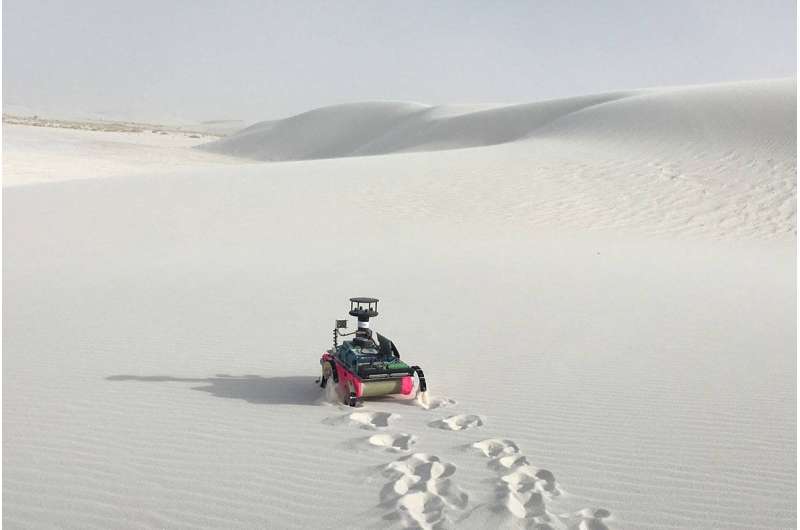Walking robots could aid research on other planets
Ryan Ewing, Robert R. Berg Professor in the Department of Geology and Geophysics at Texas A&M, and Marion Nachon, associate research scientist in geology and geophysics, are co-investigators on the project supported by NASA and led by Feifei Qian, a WiSE Gabilan Assistant Professor at the University of Southern California Viterbi School of Engineering. The aim of the research is to create and test walking, or “legged,” robots that could more easily glide through icy surfaces, crusted sand and other difficult-to-navigate environments, thus significantly enhancing scientists’ abilities to gather information from planetary bodies.
德克萨斯农工大学地质与地球物理系Robert R. Berg教授Ryan Ewing和地质与地球物理系副研究科学家Marion Nachon共同参与了这个由NASA支持、由南加州大学维特比工程学院WiSE Gabilan助理教授Feifei Qian领导的项目。这项研究的目的是创造和测试行走或“有腿”的机器人,这种机器人可以更容易地在结冰的表面、结壳的沙子和其他难以导航的环境中滑行,从而显著提高科学家从行星体收集信息的能力。
While the Mars Exploration Rovers and other robots have been successfully sent into space, they typically operate based on pre-programmed agendas that require human scientists and engineers to input detailed instructions regarding where to go and what to do prior to the robots’ arrival at the planet. As a result, when the robot encounters unexpected scenarios or discovers interesting measurements, it has limited capabilities to adapt its plan. This can hinder how robots and rovers navigate new environments or even cause them to miss scientific opportunities.
虽然火星探索漫游者和其他机器人已经成功送入太空,但它们通常是基于预先编程的议程运行的,需要人类科学家和工程师在机器人到达火星之前输入详细的指令,说明该去哪里,该做什么。因此,当机器人遇到意外情况或发现有趣的测量结果时,它调整计划的能力是有限的。这可能会阻碍机器人和漫游者在新环境中导航,甚至导致它们错过科学机会。
Ewing says enhanced understanding of how to integrate robotics technology with both planetary science and cognitive science will improve robot-aided exploration of planetary environments. This project aims to test next-generation, high-mobility robots that can agilely move through planetary surfaces and flexibly support scientific exploration goals.
Ewing说,加强对如何将机器人技术与行星科学和认知科学相结合的理解,将改善机器人辅助的行星环境探索。该项目旨在测试下一代高机动性机器人,可以灵活地在行星表面移动,并灵活地支持科学探索目标。
“We will conduct this research in two key planetary analog sites that present well-defined gradients in soil types from crusty sand at White Sands Dune Field, N. M., to icy rock mixtures at Mt. Hood, Ore.,” Ewing explained. “Our objective is to integrate high-mobility legged robots with embedded terrain-sensing technologies and cognitive human decision models to study the geotechnical properties of these soils.”
Ewing解释说:“我们将在两个关键的行星模拟地点进行这项研究,它们在土壤类型中具有明确的梯度,从新墨西哥州白沙沙丘场的硬壳砂到俄勒冈州胡德山的冰岩石混合物。”“我们的目标是将高机动性腿机器人与嵌入式地形传感技术和认知人类决策模型结合起来,研究这些土壤的岩土特性。”
The project employs “bio-inspired” robots with legs, meaning their form is modeled after animals’ unique abilities to move well on challenging surfaces like soft sand. Utilizing the latest “direct-drive” actuator technology, these robots can “feel” the terrain (e.g., sand softness and rock shapes) through their legs. This ability allows the legged robots to interact with the environment in the same manner as animals, adjusting their movement as needed.
该项目采用了“仿生”腿机器人,这意味着它们的形态模仿了动物的独特能力,可以在软沙等具有挑战性的表面上很好地移动。利用最新的“直接驱动”执行器技术,这些机器人可以通过它们的腿“感觉”地形(例如,沙子的柔软度和岩石形状)。这种能力使有腿的机器人能够像动物一样与环境互动,并根据需要调整动作。
As Qian puts it, these robots are modeled in a manner that allows them “to not just mimic how the animals look, but really understand what makes these animals successful on different terrains.”
正如钱所说,这些机器人的建模方式使它们“不仅模仿动物的样子,而且真正理解是什么使这些动物在不同的地形上成功。”
The ability to “feel” the terrain using legs also allows these robots to easily gather information about the environment as they move around and adjust exploration strategies based on this information.
利用腿“感觉”地形的能力也使这些机器人在四处移动时能够轻松收集有关环境的信息,并根据这些信息调整探索策略。
“We’ll be working to determine how the friction and erodibility of different soils is affected by surface crusts, rock-covered soils and ice content,” Ewing explained. “We will deploy the direct-drive legged robots to map soil strength at two sites that are like landscapes on the Moon, Mars and other worlds. We will simultaneously measure environmental parameters that control soil strength, including particle size and shape, soil moisture, chemical composition and ice content.”
尤因解释说:“我们将努力确定不同土壤的摩擦和可蚀性是如何受到表面外壳、岩石覆盖的土壤和冰含量的影响的。”“我们将部署直驱式腿机器人,在月球、火星和其他星球上的两个地点绘制土壤强度图。我们将同时测量控制土壤强度的环境参数,包括颗粒大小和形状、土壤湿度、化学成分和冰含量。”
As scientists continue to aspire to explore planetary environments, Qian notes the advantages of sending robots and rovers on initial missions to gather information before sending humans are significant.
钱学森指出,随着科学家们继续渴望探索行星环境,在派遣人类之前先派出机器人和漫游者执行初步任务来收集信息的优势是显著的。
Read more at Phys.org
在Phys.org阅读更多











